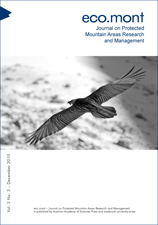Christian Komposch
S. 21 - 28
doi:
10.1553/eco.mont-2-2s21
Verlag der Österreichischen Akademie der Wissenschaften
doi:
10.1553/eco.mont-2-2s21
Abstract:
This paper deals with species whose range lies entirely (endemics) or predominantly (subendemics) within the political borders of Austria. The evolution and current distribution of Alpine endemics find their chief cause in the advent of the Pleistocene ice-ages, the destruction of much of the former fauna and in different forms of survival as well as migration from southern refugia. A first overview of endemic and subendemic arachnids of Austria shows 11 harvestman and 46 spider species. One hotspot of arachnological endemisms in the Eastern Alps are the north-eastern Calcareous Alps. The Gesäuse National Park, an exceptional area situated in the Ennstaler Alps (Styria, Austria), contains 6 subendemic harvestman and 12 endemic and subendemic spider species, i.e. 55% and 26% of the Austrian (subendemic) spectrum. Most of these Opiliones are soil-dwelling forms, most Araneae belong to the linyphiid genera Lepthyphantes s. l. and Troglohyphantes. All these species occur from the nival down to the montane zone, and prefer rock habitats, caves, avalanche corridors and natural woodlands. 100% of these harvestman and 57% of these spider species are Critically Endangered up to Vulnerable. So far, there is no legal protection for them. A main threat to those ice-age relicts is climate warming. There is a great need for conservation action on these endemics and for political support for the national park. Intensive basic research is required as well as encouragement for invertebrate specialists, the protection of endemics enshrined in law, conservation programmes and the creation of protected areas based on endemism hotspots, accompanied by public relations activities about these zoological treasures.
endemism, biodiversity, conservation, protection measures, climate warming, glaciation, Eastern Alps, Austria, Gesäuse National Park, spiders, harvestmen, Araneae, Opiliones, Arachnida
Published Online:
2010/11/24 14:57:32
Object Identifier:
0xc1aa5576 0x0024d22c
Rights:https://creativecommons.org/licenses/by-nc-nd/4.0/
The journal “eco.mont” – Journal of protected mountain areas research and management – was published for the first time in June 2009.
The journal was founded as a joint initiative of the Alpine Network of Protected Areas (ALPARC), the International Scientific Committee on Research in the Alps (ISCAR), the Austrian Academy of Sciences (ÖAW) and the University of Innsbruck.
The journal aims to highlight research on and management issues in protected areas in the Alps without excluding other protected mountain areas in Europe or overseas. Its target audiences are scientists from all related disciplines, managers of protected areas and interested individuals including practitioners, visitors, teachers, etc.
The journal presents peer-reviewed articles in English by authors who research protected mountain areas and management issues within these areas. It's published twice a year as a collaboration of the Austrian Academy of Sciences Press – responsible for the e-version – and Innsbruck University Press – responsible for the print version.
Die Zeitschrift „eco.mont“ – Zeitschrift zur Forschung in Gebirgsschutzgebieten – erschien im Juni 2009 zum ersten Mal. Die Zeitschrift wurde auf Initiative des Netzwerks Alpiner Schutzgebiete (ALPARC), der Schweizer Akademie der Naturwissenschaften (ISCAR), der Österreichischen Akademie für Wissenschaft (ÖAW) und der Universität Innsbruck gegründet. Sie hat das Ziel, Themen zu behandeln, die gleichzeitig Forschung und Verwaltung in und über die Schutzgebiete der Alpen betreffen, ohne dabei andere Gebirgsschutzgebiete Europas oder anderswo auszuschließen. Diese neue Zeitschrift richtet sich an ein Publikum von Wissenschaftlern der verschiedensten Fachbereiche, an die Verwalter von Schutzgebieten und an alle sonstigen Interessierten, Praktiker, Besucher, Lehrpersonal etc. einbegriffen. Die Zeitschrift veröffentlicht begutachtete Beiträge auf Englisch von Autoren, die Fragen der Gebirgsschutzgebieten und deren Verwaltung forschen. Sie erscheint zweimal pro Jahr, auf der Basis der gemeinsamen Anstrengungen des Verlags der Österreichischen Akademie der Wissenschaften, der für die digitale Fassung verantwortlich ist, und der Presse der Universität Innsbruck, verantwortlich für die gedruckte Fassung.



 Home
Home
 Print
Print
 References
References
 Share
Share

